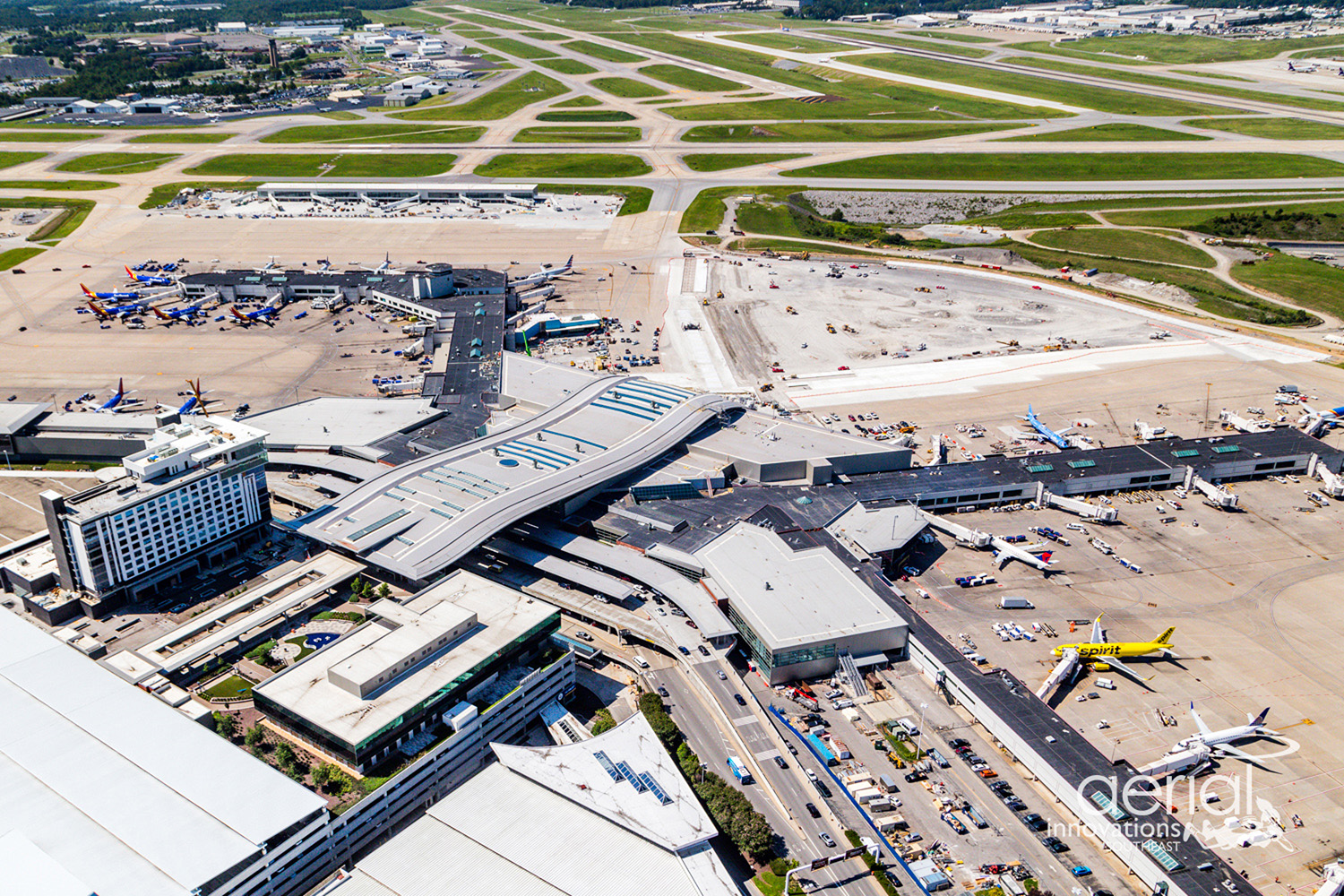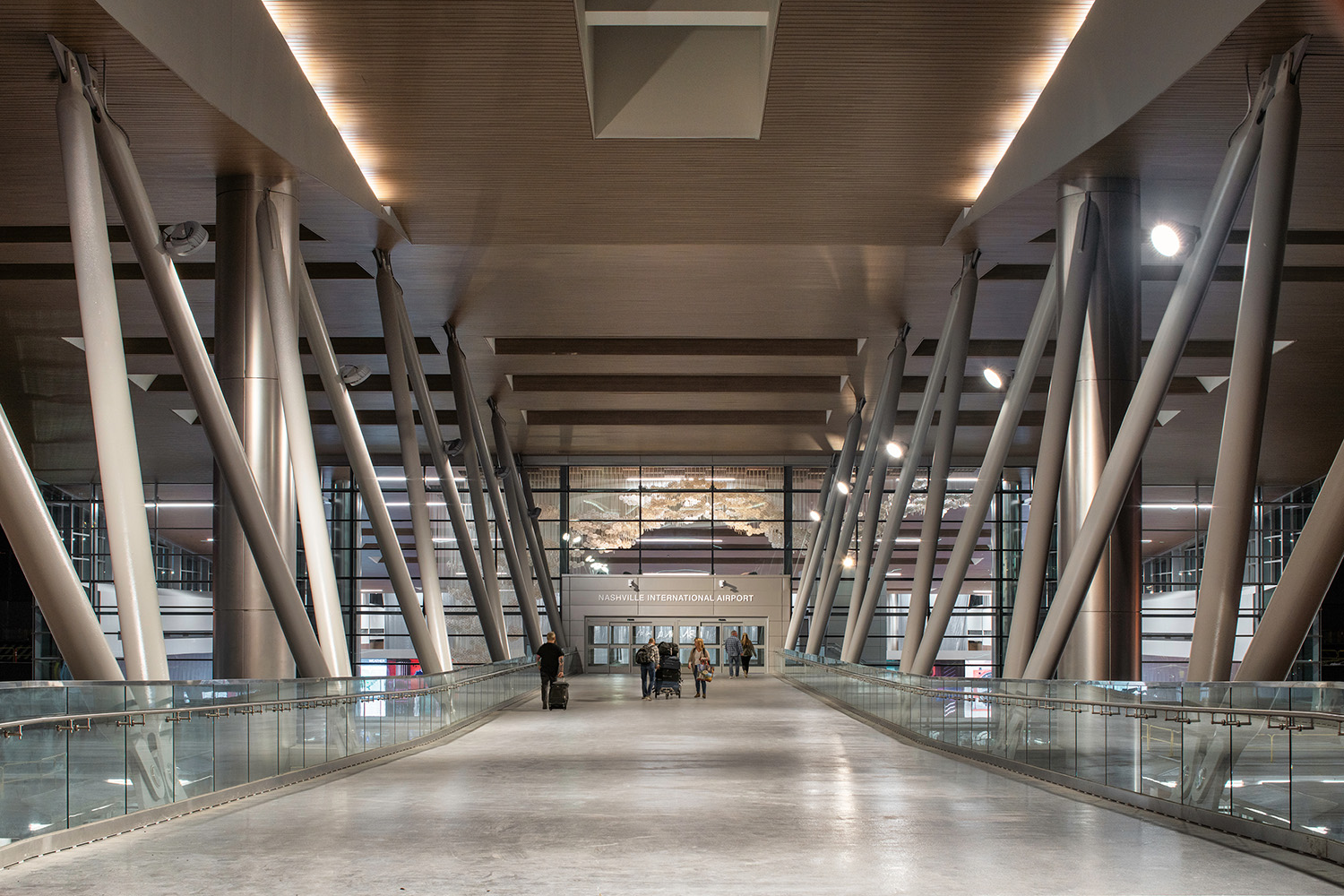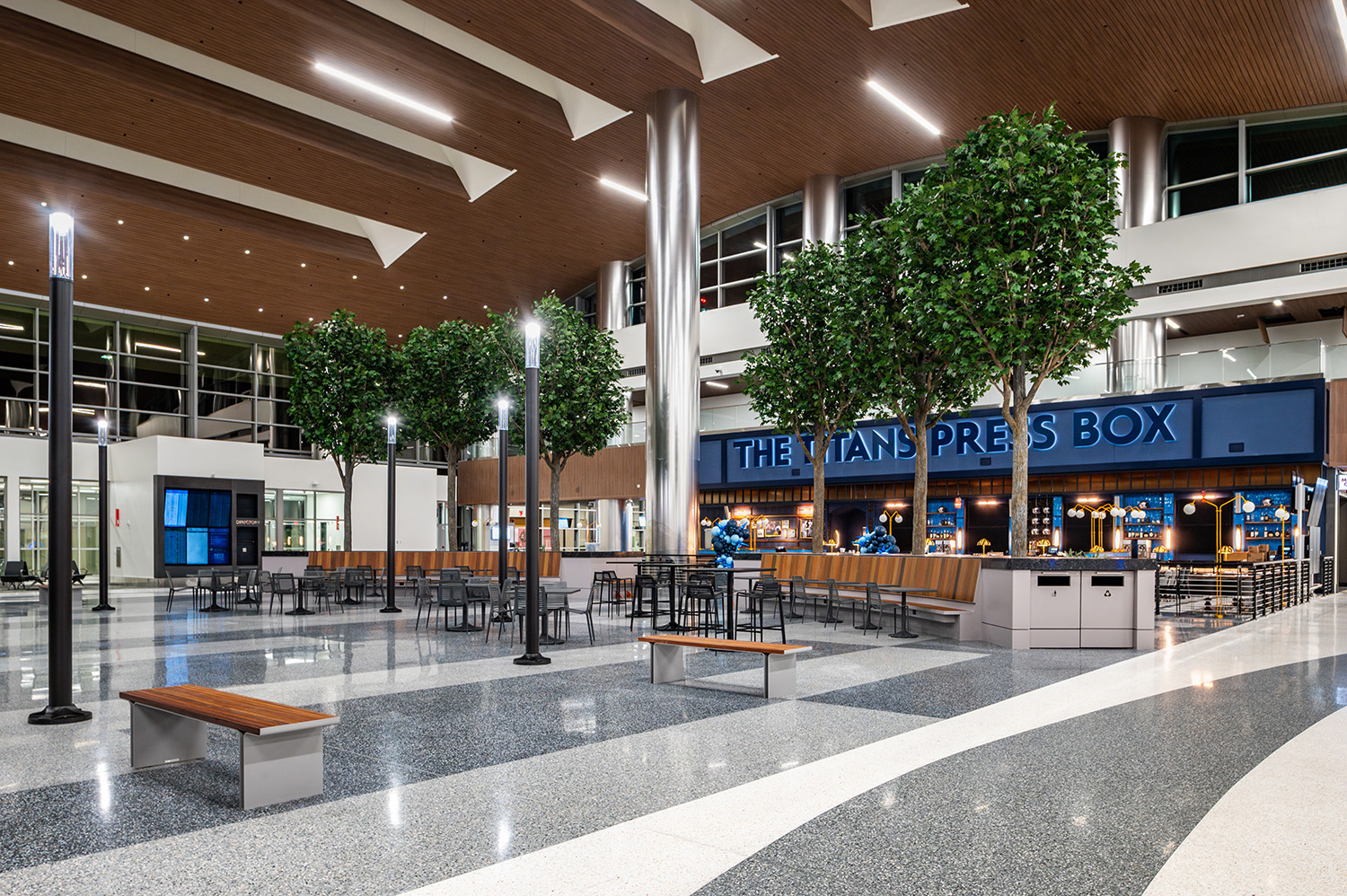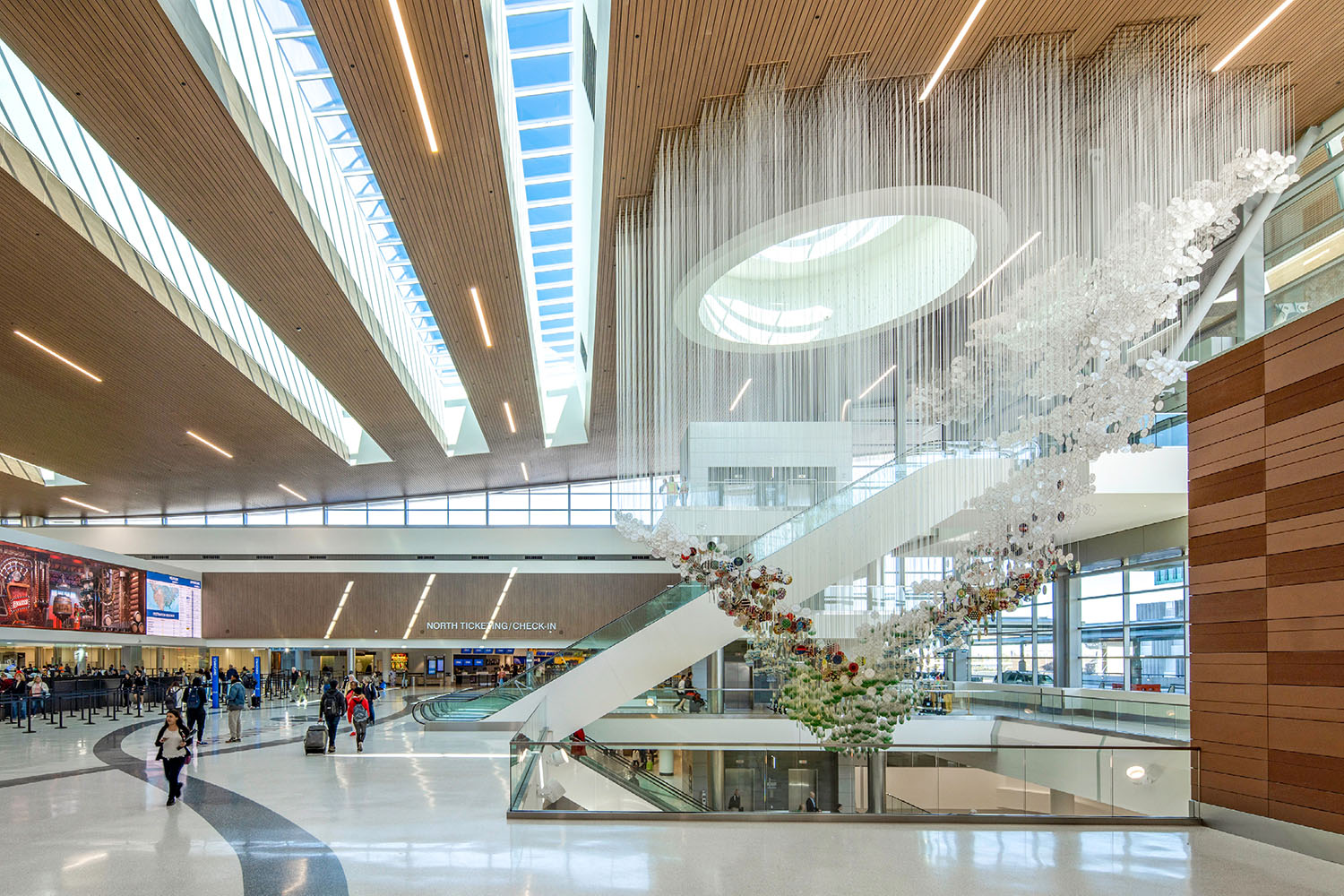AISC
Nashville International Airport Terminal Lobby and International Arrivals Facility Addition
Excellence in Engineering
"The team was very thoughtful with the form of the building itself and the roof. Passengers are going to be thinking about engineering as they walk through because it’s exposed and visible to them. It means a lot to engineers to have their structures not just seen, but seen elegantly." -- Hannah Valentine, PE, Structural Steel Specialist - Los Angeles, AISC, 2024 IDEAS² Awards Judge
The terminal lobby and international arrivals area renovations to Music City’s main airport took inspiration from an instrument.
A sweeping canopy that anchors the overhauled lobby and international arrivals facility (IAF) at Nashville International Airport (BNA) has multiple guitar-like features and resembles musical airwaves. Designing it brought some challenges. Erecting it while keeping the airport operational brought even more.
The IAF and terminal lobby project aimed to provide additional airport capacity to meet the rapidly increasing domestic and international passenger demand. Structural engineer Magnusson Klemencic Associates (MKA) and the Hensel Phelps/Fentress architect team collaborated to design and build a $436 million renovation and expansion of BNA’s terminal lobby, which includes the state-of-art IAF and a central food court featuring world-class retail, dining, and entertainment.
MKA thought beyond the project’s practicality. It wanted to create a remarkable visitor experience for the growing passenger count and be bold and beautiful in the design.
Aspirational renderings of the envisioned expanded terminal contained a grand ticketing lobby with abundant natural light and transparency. That included unencumbered views from the pedestrian bridge entry to the new international gates and a vibrant food court. To achieve this vision, MKA introduced a long-span, structural steel, curvilinear roof design that clear-spans the active roadway and terminal below. The roof design reduced the number of interior columns by 80% compared to a short-span roof design, achieving the architectural vision while significantly reducing the construction cost and schedule.
The 151,285-sq. ft structure weighs 1,750 tons and is comprised of twin, 685-ft-long contiguous spine trusses forming a gentle, wavy form symbolic of the Grand Ole Opry’s radio waves, which BNA dubbed the “airwave.” The terminal roof tapers to a finely pointed edge reminiscent of an airplane wing. Linear skylights throughout the roof evoke guitar frets, while an oculus skylight evokes the guitar’s sound hole. The grand entry lobby and airwave roof completely reshape the terminal’s form and volume, providing dramatic architectural expression.
Steel Success
Steel was the only material with merit because it provided the long spans needed to fly the new roof trusses over the existing roadway and terminal and the gentle, wavy geometric form essential to the desired architectural expression. Equally important, steel offered the most economical solution and the highest strength-to-weight ratio. Steel comprises the airwave roof’s moment frame lateral system--from steel trusses to built-up steel plate girders to cruciform steel columns--to provide unparalleled stability during and after construction.
The original bridging documents called for a braced frame lateral system, but MKA understood this system clashed with an architectural design that summoned grand open spaces. MKA prepared an alternate design scheme to show how a moment frame lateral system could capitalize on a more optimized steel design, reduce costs, and deliver on the vision for open and light-filled space.
The entire project capitalized on the power of structural steel long spans to provide maximum drama, views, and elegance with an optimized design. For example, new steel cruciform roof support columns were placed outside the new terminal’s perimeter, allowing the ticketing area, passenger screening checkpoint, and food court to be predominately column-free, since no existing columns within the interior spaces were required to support the new roof. The result is tremendous, unobstructed views and intuitive wayfinding throughout.
A mass timber roof structure would have been far more expensive and required long-term maintenance to resist adverse weather. It also needed deeper trusses that would have completely changed the roof’s desired slender form.
Likewise, concrete roof girders would have resulted in shorter spans, more support columns, and increased costs associated with bolstering roadway loads. Forming and casting a concrete roof or erecting precast girders were unviable options. With concrete, the roof structure would have been eight times heavier, and the carbon footprint would have increased dramatically if made from concrete.
Airwave Assist
The BNA project had to be completed while maintaining ongoing and uninterrupted operations throughout construction. MKA’s novel “airwave” roof traverses the existing terminal and limited disruptions to the 50,000 daily passengers that travel through the airport and on the main roadway. The new roof was the engineering equivalent of a Swiss Army Knife, with several methods that ensured no passenger interruptions and no roadway closures.
The airwave trusses and W36 cruciform columns have fixed base foundations and support the entire roof, and they needed little temporary shoring or bracing throughout steel erection. That meant steel erection could proceed over the occupied terminal and active roadway.
The airwave also acted as an umbrella that provided weather protection while contractors safely demolished the existing roof below. The cost and schedule benefits were substantial, especially because the baggage handling system and electrical components below the departures level had to stay dry and remain fully operational throughout construction.
The existing columns were not needed to support the new roof, meaning workers didn’t have to strengthen the existing columns and foundations--another considerable schedule and cost-benefit. Before it was demolished, the existing terminal roof was a safe temporary work platform to facilitate the installation of the new roof’s mechanical, electrical, piping, and ceiling supports within. Installation was six times faster than using scissor lifts on the departures level to install these systems.
Once the new, long-span steel airwave roof was in place and weather-tight, the new steel roof trusses were used by the demolition contractor to rig from and safely demolish the existing roof below.
The airwave spans the arrivals roadway with two curvilinear mega-trusses supporting the new pedestrian bridge from the adjoining parking garage to the new Grand Entry Lobby. Hollow structural section (HSS) pipe diagonals laced between the lower bridge girder and the upper roof trusses allow the bridge to meet stringent vibration criteria. Cast Connex attached sleek steel castings to these girders, eliminating the need for bulky, bolt-laden gusset plates that would have restricted views through the glass handrailing on the pedestrian bridge.
The airwave’s engineering was innovative beyond its ability to keep the airport open during construction. The steel roof structure was fabricated precisely to create the true roof geometry (for example, the one-and-the-same roof profile shadows the steel profile) and achieve the sleek and iconic airwave form essential to the architectural design intent. Like an airwave that rolls gently through the sky, the light and delicate roof form created by the steel fabricator allows ceiling, roofing, and skylight elements to be attached directly to the steel structure.
Throughout the design process, MKA worked closely with the fabricators and steel detailers to embrace constructability details that performed best. Truss splice locations were positioned so the trusses could be fabricated, shipped to the site, and erected fast, safely, and quickly. Each member fit seamlessly.
Elsewhere, the straight trusses were prefabricated in the shop and shipped to the site. They spanned between and through the spine trusses to complete the roof’s undulating form with straightline-generated geometry, greatly simplifying fabrication and erection. Straight trusses also formed beautiful recesses in the ceiling finish so light from the linear skylights above could cascade onto the floor below, creating a remarkable, naturally lit space.
As a finishing architectural expression, the truss cantilever reminiscent of an airplane wing allows architectural cladding elements to be attached directly to the structure. Suspended art hangs directly from the structure above to create a phenomenal impression in the entry lobby.
Constructability and Sustainability
Hensel Phelps, Fentress, and MKA involved the steel fabricators and erector early in the project to provide valuable design assist input on prefabrication, connections, and erection.
The 685-foot-long dual spine trusses were designed and fabricated to be only 10 ft deep, facilitating pre-assembly at the fabrication plant and shipping to the site, minimizing cost- and schedule-related issues. In addition, the fabricators suggested MKA incorporate steel castings into the pedestrian bridge design to achieve a clean and simple pinned connection that preserved views while meeting stringent vibration criteria.
The design team working closely with the steel fabricator and erector early on provided insights on refining roof geometric clarity for the radial arcs and tangents of the desired roof form and determining the most cost-effective way to bend and connect the steel roof members. MKA determined at design inception that inserting the two longitudinal steel spine trusses traversing the 685-foot-long airwave roof--from the parking garage to the airfield--would best create the long-span roof form. That solution minimized the number of curved trusses, eased fabrication costs, and enhanced the roof’s stability during erection.
Input from the steel erector and fabricator led MKA to change the moment frame connections from welded to field-bolted, minimizing steel erection time and reducing costs. During the design phase, the steel team vetted the tower crane’s reach to ensure it could span the occupied roadway and placed a tower crane directly through the roof’s oculus skylight opening to facilitate erecting steel above the terminal and roadway.
When expanding and renovating existing facilities, the most effective sustainable design solutions revolve around reusing and repurposing as much of the existing structure as possible, embracing solutions that do not require strengthening or demolishing the existing structure, and avoiding rebuilding with all new materials. The reuse efforts reduced the renovated terminal’s carbon footprint by 50%, and all demolished steel was recycled.
Spanning the existing roadway with the airwave roof meant the project team did not need to strengthen the existing roadway, avoiding expensive, time-consuming, and disruptive measures such as roadway- related seismic upgrades, column strengthening, and micropiles.
The project design reused the existing terminal’s departures, apron, mezzanine, and basement levels. Further, some of the original roof support columns were simply trimmed off and repurposed to support a video screen wall in front of the passenger screening checkpoint. The new design also employed an existing upper-level office floor as a new mechanical room.
The old terminal building remains, but passengers have little way of knowing as they stroll through the pedestrian bridge, into the column-free grand lobby, and onward to the vast retail and dining area--all with spacious views, natural light, and openness.
For more on the Nashville International Airport project, see “Riding The Wave” in the October 2022 issue of Modern Steel Construction.
Owner: Metropolitan Nashville Airport Authority, Nashville
General contractor: Hensel Phelps, Nashville
Architects: Fentress Architects, Denver; TMPartners, Brentwood, Tenn.; Corgan Associates, Dallas (BNA Vision Design Architect)
Prime structural engineer: Magnusson Klemencic Associates, Seattle
Foundation engineer: Logan Patri Engineering, Inc., Nashville
Steel team:
- Fabricators:
- Banker Steel, Lynchburg, Va. *AISC full member; AISC-Certified fabricator*
- Irwin Steel LLC, Justin, Texas *AISC full member; AISC-Certified fabricator*
- TrueNorth Steel, Lubbock, Texas *AISC full member; AISC-Certified fabricator*
- Erector: Schuff Steel Company, Euless, Texas *AISC full member; AISC-Certified fabricator and erector*
- Bender/roller: Chicago Metal Rolled Products, Chicago *AISC associate member*
- Location: Nashville, TN
- Submitting Firm: Magnusson Klemencic Associates
- Photo Credit: 1, 3, 7, 8 - Jordan Powers; 2 - Aerial Innovations; 4 - MKA; 5, 6 - Matt Good








